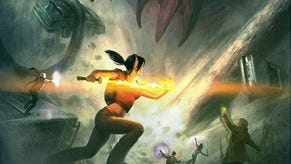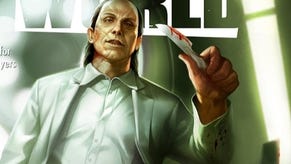The Secret World
The modern-day MMO previewed, Ragnar Tornquist interviewed.
Click through to page two for an exclusive chat with The Secret World's writer/director, Ragnar Tornquist. Read on below for our impressions from a live demo at this year's Game Developers Conference. Preview by Oli Welsh. Interview by Robert Purchese.
If nothing else, Funcom is enjoying the opportunities for creative PR afforded by the real-world, modern-day setting of its next MMO, The Secret World.
The last time we met the Norwegian developer to see the game, we were in a fake Irish pub in Cologne's Koelnmesse exhibition hall. This time, at the Game Developers Conference in San Francisco, we're in a circular chamber in a sort of post-deco style, with a beautifully restored 1906 carousel outside.
The atmosphere of cultured, contemporary creepiness is only slightly spoiled by THQ choosing the same venue to stage a lunchtime thrash metal concert to promote Homefront.
We've seen The Secret World a few times before, but this is our first chance to see it played in a live demo and the first opportunity to catch up with it since EA signed a deal to distribute the game.
Funcom won't discuss a release date yet, but Tornquist, joined by designers Joel Bylos and Martin Bruusgaard, does reveal that his baby will be starting its first internal beta test within the next month or two.
To recap, The Secret World is an open-world MMO with free-form character progression set in the present day. Players join one of three competing secret societies – the Dragon (based in Seoul), Illuminati (New York) and Templars (London) – to combat a nameless, occult evil that is threatening the world, and prove virtually every popular conspiracy theory true in the process.
If EverQuest channels D&D and EVE Online expounds on Iain M. Banks, The Secret World mashes up Buffy, The X Files and H. P. Lovecraft.
We begin by running through some missions in the starter area of Kingsmouth, a sleepy, autumnal New England community overrun by zombies and some kind of alien or demonic infestation on the beach.
Tornquist is piloting a blonde girl in a hoodie, dual-wielding pistols; traditional MMO lock-on targeting is in evidence, unlike the reticle-aiming we've seen in previous videos.
Still, the action is faster and more fluid, if less crisply defined, than the genre norm as the team of four battle large crowds of zombies in the woods, setting them on fire or using car alarms to summon new spawns.
Server structure is still to be decided but The Secret World will use very little instancing. Funcom prefers to have players collide, co-operate and socialise on large persistent maps and in dynamic encounters.
Later we pick up a new mission from a policeman, a haunted, hollow-eyed deputy standing atop a barricaded building. As with BioWare's Star Wars: The Old Republic there's a focus on voiced mission dialogue, but it's less long-winded and the characterisation has more humanity.
The floating text of the virtual reality-style interface is a nice touch, as are the "tiers" that save your progress through missions which seem longer and more involved that your average quest.
An interesting new gameplay style is offered by Investigations, non-combat detective missions in which players follow a trail of clues – sometimes leading outside of the game – to solve a mystery.
Tornquist's adventure gaming roots show here: in the mission we're shown, a series of Illuminati symbols on drain covers lead players to two names, which when Googled help solve a clue leading to a clock leading to a Bible verse leading to a code leading to a cache of gear.
With no levelling or character classes as such, gear – weapons, costumes and trinkets (there's no armour) – forms a substantial part of The Secret World's character progression.
So does the acquisition of skills, with complete freedom, from a sort of radial pie chart (though there are suggested paths through this for the less experimental player). Seven active and seven passive skills can be equipped at a time and combat revolves around ranged weapons, melee fighting and magic.
We're so used to measuring our progress through RPGs in numerical bands it's a little hard to get your head around, but Bruusgaard and Bylos promise the system should be intuitive.
Action-adventure-style lock-and-key mechanics based around skills or items will pace your progress through the content. There will be achievements to earn and your rank within your secret society will have a major effect on gameplay (as well as bragging rights, naturally).
The last piece of the puzzle is our first look, in video only, at The Secret World's player-versus-player element. In contrast to the rest of the game, what's shown so far seems to have a very conventional approach.
In this "gentleman's war", the three societies – who are free to mingle and co-operate in PVE – vie for control of the magical hotspots of Stonehenge, Eldorado and the lost Himalayan city of Shambala.
Sounds mysterious, but these locations prosaically translate into maps for king of the hill, capture the flag and ranked arena deathmatch. Eldorado looks the most interesting, with an asymmetrical map for three teams of 10, and "flags" replaced by skull-style idols which have to be held on to rather than delivered.
It's the most convincing demo yet for The Secret World, and the game is an undoubted fresh breath for MMOs in style and setting, if nothing else. But nor is it as confident and clear a manifesto for the future of the genre as Guild Wars 2.
It's hard to tell if a certain vagueness in the game's presentation should be attributed to a deliberate air of mystery, actual indecisiveness in development, or simply the fact that its unusual design will only successfully communicate itself first-hand. To answer that, we'll have to wait for the first hands on; until then, read on to see if Tornquist can convince you.









.png?width=291&height=164&fit=crop&quality=80&format=jpg&auto=webp)




.jpg?width=291&height=164&fit=crop&quality=80&format=jpg&auto=webp)
